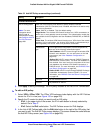
Virtual Private Networking Using IPSec and L2TP Connections
235
ProSafe Wireless-N 8-Port Gigabit VPN Firewall FVS318N
4. Complete the settings as explained in the following table. The only differences between IPv4
and IPv6 settings are the subnet mask (IPv4) and prefix length (IPv6).
Table 54. Add New VPN Policy screen settings for IPv4 and IPv6
Setting Description
General
Policy Name A descriptive name of the VPN policy for identification and management
purposes.
Note: The name is not supplied to the remote VPN endpoint.
Policy Type From the drop-down list, select o
ne of the following policy types:
• Auto Policy. So
me settings (the ones in the Manual Policy Parameters
section of the screen) for the VPN tunnel are generated automatically.
• Manu
al Policy. All settings need to be specified manually, including the ones
in the Manual Policy Parameters section of the screen.
Remote Endpoint Select a radio button to specify how the remote endpoint is defined:
• IP Ad
dress. Enter the IP address of the remote endpoint in the fields to the
right of the radio button.
• FQ
DN. Enter the FQDN of the remote endpoint in the field to the right of the
radio button.
Enable NetBIOS? Select this check box to enable NetBIOS bro
adcasts to travel over the VPN
tunnel. For more information about NetBIOS, see Configure NetBIOS Bridging
with IPSec VPN on page 262. This feature is disabled by default.
Enable Auto Initiate Select this check box to enable the VPN tun
nel to autoestablish itself without the
presence of any traffic.
Note: The direction and type of the IKE policy that is associated with this VPN
pol
icy need to be either Initiator or Both but cannot be Responder. For more
information, see Manually Add or Edit an IKE Policy on page 224.
Enable Keepalive
Note: See also
Configure Keep-Alives
and Dead Peer
Detection on
page 259.
Select a radio button to specify if keep-alive is enabled:
• Ye
s. This feature is enabled: Periodically, the wireless VPN firewall sends
keep-alive requests (ping packets) to the remote endpoint to keep the tunnel
alive. You need to specify the ping IP address in the Ping IP Address field, the
detection period in the Detection Period field, and the maximum number of
keep-alive requests that the wireless VPN firewall sends in the Reconnect
after failure count field.
• No. T
his feature is disabled. This is the default setting.
Ping IP Address The IP address that the wireless VPN firewall pings. The
address needs to be of a host that can respond to ICMP
ping requests.
Detection Period The period in seconds between the keep-alive requests. The
defaul
t setting is 10 seconds.
Reconnect after
fa
ilure count
The maximum number of keep-alive requests before the
wireless VPN firewall tears down the connection and then
attempts to reconnect to the remote endpoint. The default
setting is 3 keep-alive requests.


















